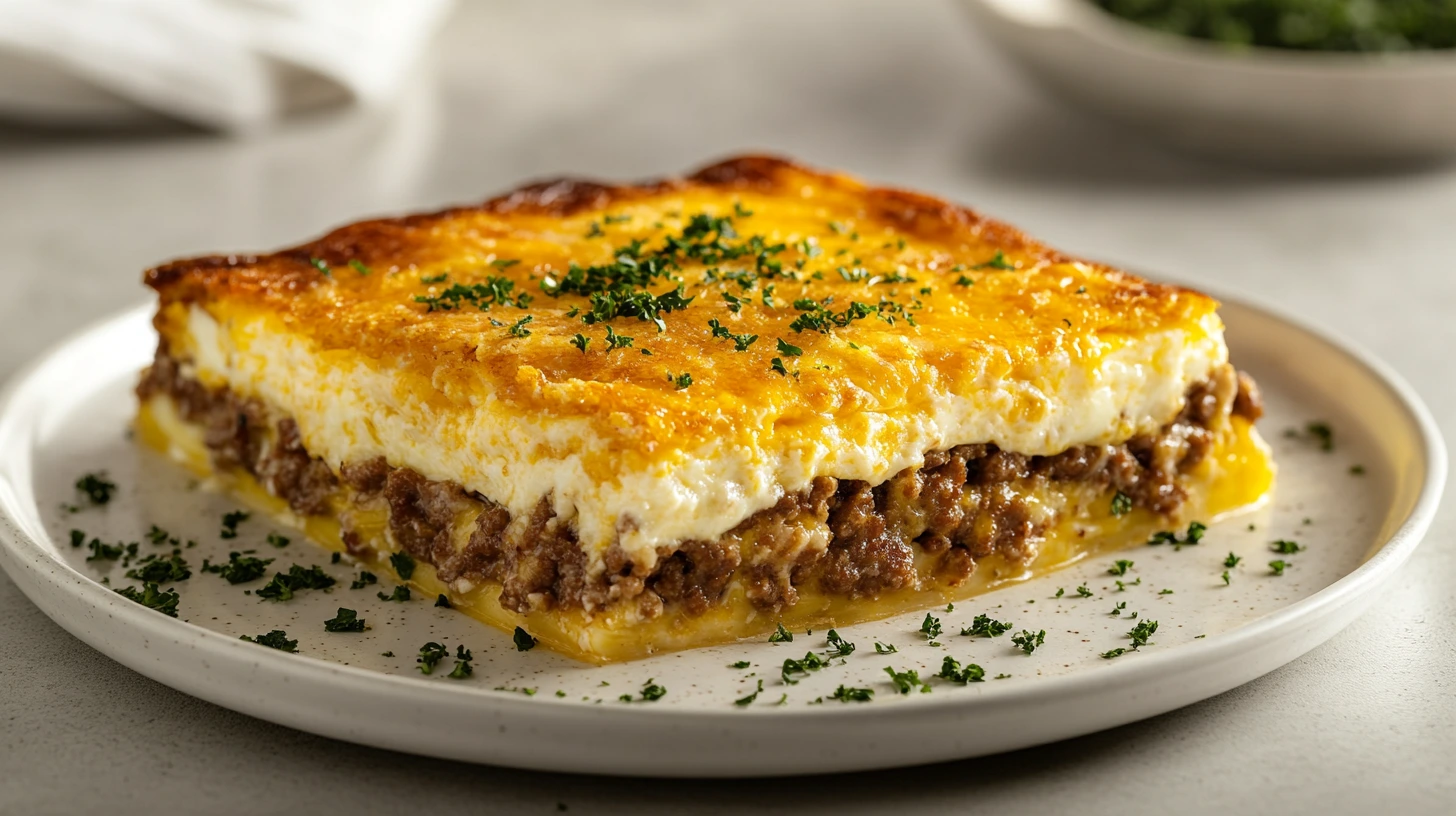If you’re following a low-carb lifestyle or just trying to eat healthier without sacrificing flavor, you’ve probably already heard about the keto diet. It’s a high-fat, moderate-protein, and low-carb approach to eating that has skyrocketed in popularity for its health benefits, including weight loss and improved energy levels. But let’s be honest—mornings can be rough. And when you’re trying to stick to keto, finding a quick, delicious, and filling breakfast that doesn’t throw off your macros can be tricky. That’s where the keto breakfast casserole comes in.
This warm, cheesy, protein-packed dish is a total game-changer for busy mornings, weekend brunches, and even meal prepping for the week ahead. Whether you’re juggling work, kids, or just need something satisfying to keep you full until lunch, a keto breakfast casserole offers the perfect balance of nutrition and taste. It’s also incredibly customizable—think of it as your low-carb canvas where you can mix and match ingredients to suit your cravings.
In this ultimate guide, we’ll dive deep into everything you need to know about keto breakfast casseroles. From how they fit into a ketogenic lifestyle to the best ingredients, tasty variations, and step-by-step instructions—you’ll walk away fully equipped to whip up your own version at home. Plus, we’ll share pro tips on storage, meal prep, nutrition, and even freezing your casserole for future meals.
Whether you’re a seasoned keto veteran or just getting started, this article will show you 10 delicious reasons why this dish should become a staple in your weekly routine. Let’s dig in and discover why the keto breakfast casserole is so much more than just eggs and cheese.
Looking for more breakfast inspo? Try this hearty Shakshuka With Sourdough Breakfast for another egg-based favorite.
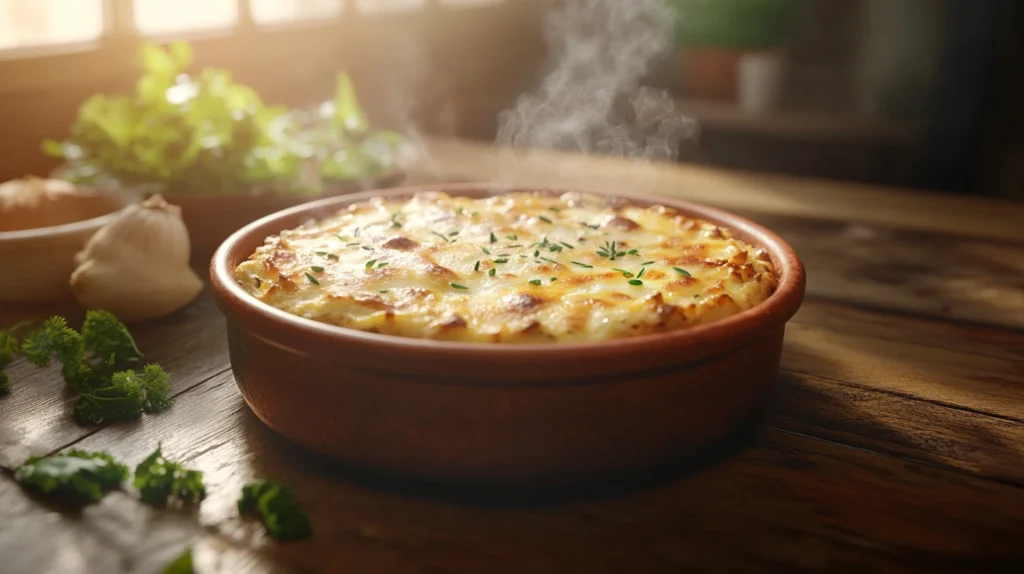
What is a Keto Breakfast Casserole?
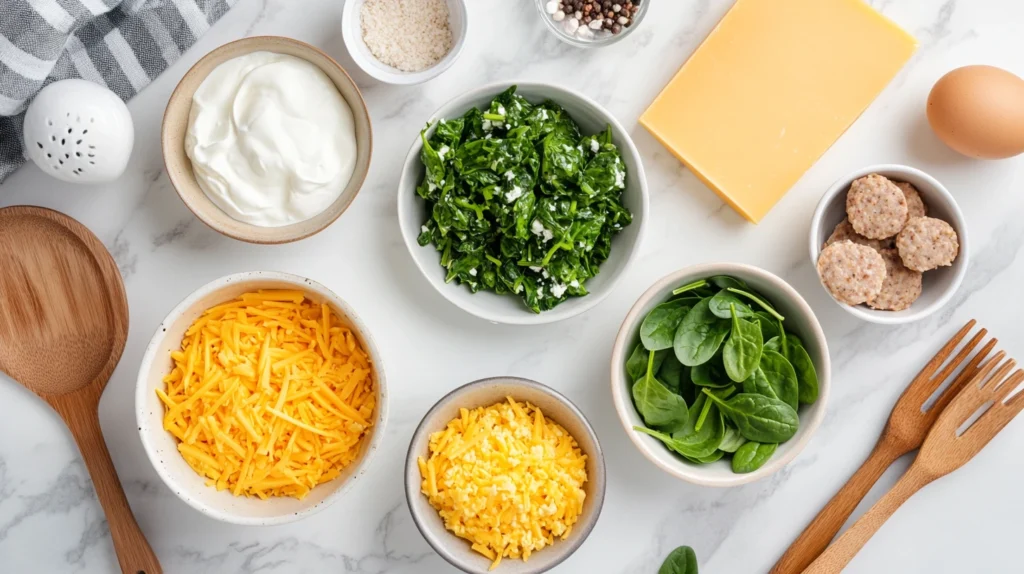
Understanding Keto Breakfast Casseroles and Their Nutrition
A keto breakfast casserole is a savory, baked dish typically made with a combination of eggs, cheese, meats (like sausage or bacon), and low-carb vegetables such as spinach, bell peppers, or broccoli. What sets it apart from regular breakfast casseroles is its strict adherence to the macronutrient principles of the ketogenic diet: high fat, moderate protein, and very low carbohydrates.
To qualify as truly “keto,” the casserole must contain minimal carbs—usually under 5g net carbs per serving—while providing ample healthy fats and quality proteins to keep you feeling full and energized. There’s no room for bread, potatoes, or starchy fillers here. Instead, ingredients like cream, full-fat cheese, avocado oil, and meats step in to supply the fat content needed to keep your body in a state of ketosis.
And the best part? It doesn’t feel like you’re giving anything up. Keto breakfast casseroles can be rich, cheesy, and bursting with flavor, while still supporting your health goals. They make an ideal option for people who want a hearty breakfast that also aligns with their macros.
If you’re already a fan of brunch-friendly bakes like Kentucky Cream Pull Candy (though not keto!), you’ll love how comforting this casserole feels—minus the sugar.
How Keto Egg Casserole Fits the Low-Carb Lifestyle
The ketogenic diet relies on fat as the primary fuel source, which means your meals need to be strategically designed to keep carb intake very low—typically around 20–50 grams of net carbs per day. A keto breakfast casserole supports this by:
- Reducing carb intake: By skipping traditional high-carb ingredients like bread, potatoes, and flour, the dish remains keto-friendly.
- Increasing healthy fats: Ingredients like eggs, cheese, heavy cream, butter, and meats help increase dietary fat.
- Providing adequate protein: Essential for muscle maintenance, eggs, sausage, and other proteins add necessary fuel without spiking insulin levels.
- Boosting satiety: High-fat meals are more satisfying and help reduce hunger throughout the day.
For those in nutritional ketosis, this casserole can be an easy, delicious way to stay on track without overthinking your morning meal. It’s also a fantastic meal prep item since it can be portioned and stored for multiple days—making it a go-to option for anyone managing a keto lifestyle on a tight schedule.
Another bonus? Because it’s naturally gluten-free, it also appeals to those avoiding gluten for medical or personal reasons. Whether baked fresh or reheated, keto breakfast casseroles offer a practical, versatile, and satisfying way to start your day.
Hosting a brunch soon? Pair your casserole with a festive Spiced Cranberry Punch for a vibrant, keto-friendly drink option.
Why Choose Keto Breakfast Casserole for Your Morning Meal?
Health Benefits of a Keto-Friendly Breakfast Casserole
One of the biggest advantages of choosing a keto breakfast casserole is that it aligns perfectly with the health goals of a ketogenic lifestyle. Starting your day with a meal rich in healthy fats and proteins—not sugar or refined carbs—helps stabilize blood sugar levels, improve focus, and promote long-lasting energy.
Here are just a few key health benefits of eating a keto-friendly breakfast casserole:
- Supports Fat Burning: When your body is in ketosis, it burns fat for energy instead of carbohydrates. A keto casserole, full of eggs, cheese, and healthy fats, keeps you in that fat-burning zone.
- Improves Mental Clarity: Many people report feeling more focused and alert when they start their day with a high-fat, low-carb meal—thanks to more stable energy levels and fewer glucose crashes.
- Reduces Cravings: High-fat meals increase satiety hormones like leptin, meaning you’ll feel full longer and reduce the urge to snack between meals.
- Regulates Blood Sugar: For those managing insulin resistance, pre-diabetes, or type 2 diabetes, avoiding carbs first thing in the morning helps maintain steady blood glucose levels throughout the day.
- Supports Heart Health: When made with high-quality fats like avocado oil, pasture-raised eggs, and nitrate-free meats, keto breakfast casseroles can contribute to healthier cholesterol levels.
Not only are these casseroles nutritionally dense, but they also give your body the fuel it truly needs—without the crash that comes from carb-heavy breakfast staples like pancakes or toast.
Meal Prep Made Easy with Low Carb Breakfast Casseroles
Let’s face it: mornings can be hectic. Whether you’re juggling school runs, work meetings, or just trying to get out the door on time, breakfast often gets pushed to the bottom of the priority list. That’s another reason why keto breakfast casseroles shine.
They’re ideal for meal prepping, meaning you can:
- Make it once, eat it all week: Bake a large casserole on Sunday, cut it into portions, and store in the fridge or freezer for grab-and-go meals all week.
- Save cooking time during busy mornings: No need to start from scratch each day—just heat and eat.
- Customize per household preferences: Split one big casserole into halves with different fillings (e.g., mushrooms and spinach on one side, bacon and jalapeños on the other).
- Serve a crowd: Hosting a brunch or need to feed the family quickly? A keto casserole offers the perfect one-dish solution that pleases all taste buds.
Meal prepping with a keto breakfast casserole also makes it easier to track your macros. You know exactly what’s in each slice, so you can plan your day’s meals with accuracy and confidence—crucial for staying in ketosis.
In a nutshell, keto breakfast casseroles are more than just a trend—they’re a lifestyle-friendly, nutritious, and time-saving answer to the eternal question: “What’s for breakfast?”
Core Ingredients in the Best Keto Breakfast Casserole
Low-Carb Vegetables That Work Well in Keto Casseroles
Vegetables bring texture, flavor, and fiber to your casserole—but not all veggies are keto-approved. Choosing the right low-carb vegetables ensures your casserole stays within your target carb range while still being nutrient-rich.
Here are some excellent options:
- Spinach is loaded with iron, magnesium, and fiber, making it a nutrient-dense, low-carb addition to any keto dish.It wilts down easily and blends well with eggs and cheese.
- Bell Peppers (in moderation): Use small amounts for color and crunch, especially red or green bell peppers.
- Zucchini: Adds moisture and bulk, especially when shredded or diced.
- Broccoli: Packed with antioxidants and fiber—just be sure to chop it into small florets for even cooking.
- Cauliflower: A classic keto substitute for potatoes; great for extra heartiness.
- Mushrooms: Earthy and flavorful, they bring umami and a meaty bite to your dish.
Avoid starchy vegetables like potatoes, corn, or peas, as they are high in carbs and can disrupt ketosis.
Protein and Fat Sources for a Keto Egg Casserole
Protein is essential in every breakfast, especially for satiety and muscle maintenance. Luckily, there are a variety of protein options that also deliver healthy fats—a keto requirement.
Here are some top picks:
- Eggs: The backbone of any breakfast casserole. Eggs bind all the ingredients together and provide excellent fat and protein content.
- Sausage: Choose sugar-free, nitrate-free breakfast sausage for flavor and healthy fats.
- Bacon: Crispy, smoky, and fatty—perfect for flavor. Pre-cook and crumble into the mix.
- Ham: Diced ham adds a leaner protein profile. Look for low-sodium, nitrate-free options.
- Ground beef or turkey adds a rich, hearty texture and makes the casserole more filling and satisfying.le. Opt for higher fat percentages to keep it keto-friendly.
- Shredded rotisserie chicken: A tasty option when you want to use leftovers.
Add healthy fats like avocado slices, coconut oil, or butter into your base for extra richness and sustained energy.
Keto-Friendly Cheeses and Dairy for Casserole Perfection
Dairy plays a huge role in delivering flavor, creaminess, and fat in a keto breakfast casserole. However, not all dairy is created equal—some options are better suited for maintaining low carb counts and avoiding unnecessary sugars.
Consider these keto-approved dairy ingredients:
- Cheddar cheese: Sharp and flavorful with zero carbs.
- Mozzarella cheese: Mild and melty—ideal for binding layers.
- Cream cheese: Adds smooth texture and richness.
- Parmesan: Great for topping and a salty kick.
- Heavy cream: A better option than milk for the liquid base—rich in fat, low in carbs.
- Full-fat sour cream: Can be used in small amounts for tanginess and moisture.
If you’re dairy-sensitive, swap out cheese with dairy-free alternatives like nut-based cheese or coconut cream. Just be sure to check labels for added sugars or hidden carbs.
Together, these ingredients create a dish that’s low in carbs, high in flavor, and extremely satisfying. The best part? They’re endlessly customizable. You can mix and match based on what’s in your fridge or what you’re craving. Just remember to keep an eye on carb counts and choose whole, unprocessed ingredients whenever possible.
How to Make a Keto Breakfast Casserole Step by Step
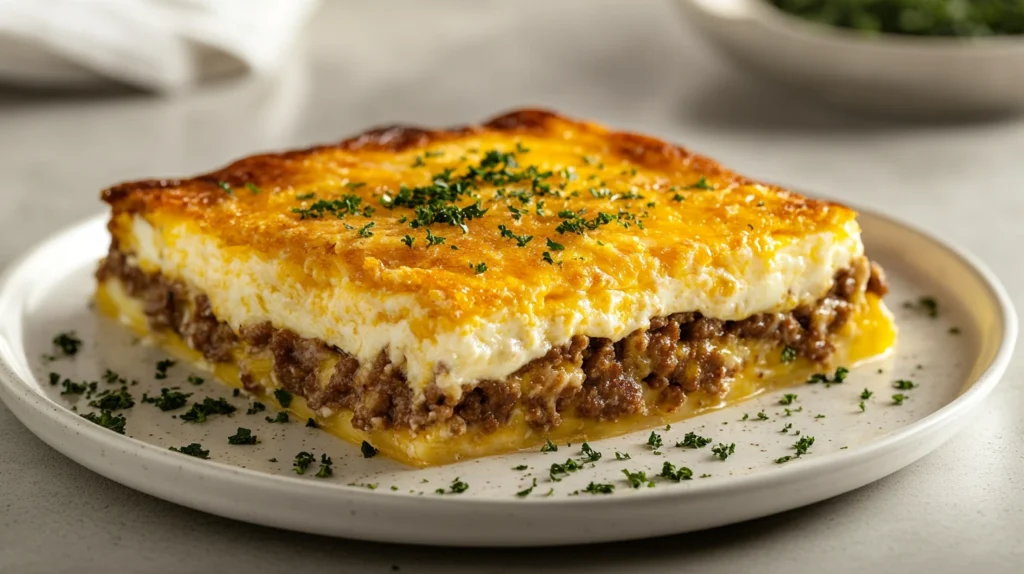
Prep, Cook, and Portion Your Keto Morning Casserole
Before we dive into the instructions, here’s a quick overview of what to expect:
- Prep Time: 10–15 minutes
- Cook Time: 35–45 minutes
- Total Time: 50–60 minutes
- Servings: 6 to 8 slices
This makes it a great choice for meal prepping or feeding a small group for brunch or a weekend breakfast.
Cooking Instructions
Here’s a simple, reliable recipe for a classic keto breakfast casserole:
Ingredients:
- 10 large eggs
- 1 cup heavy cream
- 1 cup shredded cheddar cheese
- 1/2 cup mozzarella cheese (optional)
- 1/2 pound breakfast sausage (sugar-free)
- 1/2 cup diced bell peppers
- 1/2 cup chopped spinach or kale
- Salt and pepper to taste
- 1 tsp garlic powder
- 1/2 tsp paprika
- Butter or coconut oil for greasing
Step-by-Step Instructions:
- Preheat your oven to 375°F (190°C) and lightly grease a 9×13-inch baking dish with butter or coconut oil.
- Brown the sausage in a skillet over medium heat until it’s fully cooked and nicely caramelized. Drain any excess grease and set aside.
- Lightly sauté the vegetables, such as spinach and bell peppers, for 2–3 minutes until they begin to soften.This step helps prevent soggy casserole later.
- In a large mixing bowl, whisk together eggs, heavy cream, garlic powder, paprika, salt, and pepper until smooth and frothy.
- Mix in the cheeses, browned sausage, and softened vegetables until evenly combined.Mix well to evenly distribute all ingredients.
- Transfer the mixture to the greased baking dish and spread it evenly using a spatula.
- Bake for 35 to 45 minutes, or until the center is firm and the top turns a light golden brown.Insert a toothpick or knife into the center—if it comes out clean, the casserole is done.
- Let it cool for 5–10 minutes before slicing. This helps the casserole set for clean cuts and better texture.
You can refrigerate leftovers for up to 4 days or freeze individual portions for up to 2 months.
Flavorful Variations of Keto Breakfast Casserole
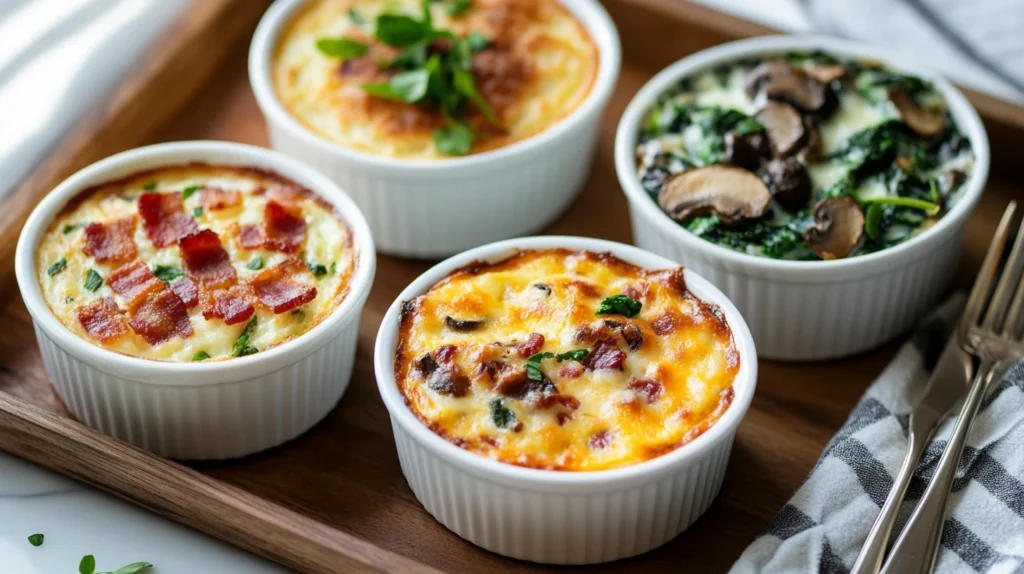
Tired of the same old flavor combo? Here are some exciting, keto-friendly variations to spice things up:
Sausage and Spinach Keto Casserole Combo
- Swap the peppers for extra spinach, add a bit of feta cheese for tang, and use mild or spicy Italian sausage.
- Sprinkle with oregano and a dash of red pepper flakes for Mediterranean flair.
Bacon, Broccoli, and Cheddar Low Carb Casserole
- Use crumbled crispy bacon, finely chopped broccoli florets, and extra-sharp cheddar cheese.
- Enhance the flavor with a dash of onion powder and a touch of Dijon mustard for a hint of sharpness.
Dairy-Free and Vegetarian Keto Egg Casserole Options
- Dairy-free: Replace heavy cream with coconut milk or unsweetened almond milk; use dairy-free cheese like cashew-based mozzarella.
- Vegetarian: Skip the meat and bulk up the casserole with mushrooms, kale, sun-dried tomatoes, and extra eggs or tofu.
These versions keep your breakfasts interesting and keto-compliant without much extra effort. Whether you’re craving spicy, cheesy, or something plant-based, there’s a variation for every palate.
Mistakes to Avoid When Making Keto Breakfast Casseroles
Even though making a keto breakfast casserole is pretty straightforward, a few small missteps can affect the texture or flavor. Here’s what to watch out for:
Ingredient Ratios That Can Ruin a Keto Casserole
- Too many veggies: While vegetables are healthy, overloading your casserole with high-moisture veggies like zucchini or mushrooms without sautéing them first can make it soggy.
- Not enough eggs: Eggs are the base and binding agent. Using too few can cause your casserole to lose structure and fall apart.
- Overmixing: Whisking too hard or too long can add too much air, causing uneven texture when baking.
Cooking Times and Temperatures for Perfect Egg Bake
- Undercooked: Results in a jiggly center that doesn’t hold shape when sliced.
- Overcooked: Causes dry, rubbery eggs.Test for doneness by inserting a toothpick or lightly pressing the center to ensure it’s fully set.
Bake until just set, and remember the casserole continues to cook slightly after being removed from the oven.
Storing, Freezing & Reheating Your Keto Breakfast Casserole
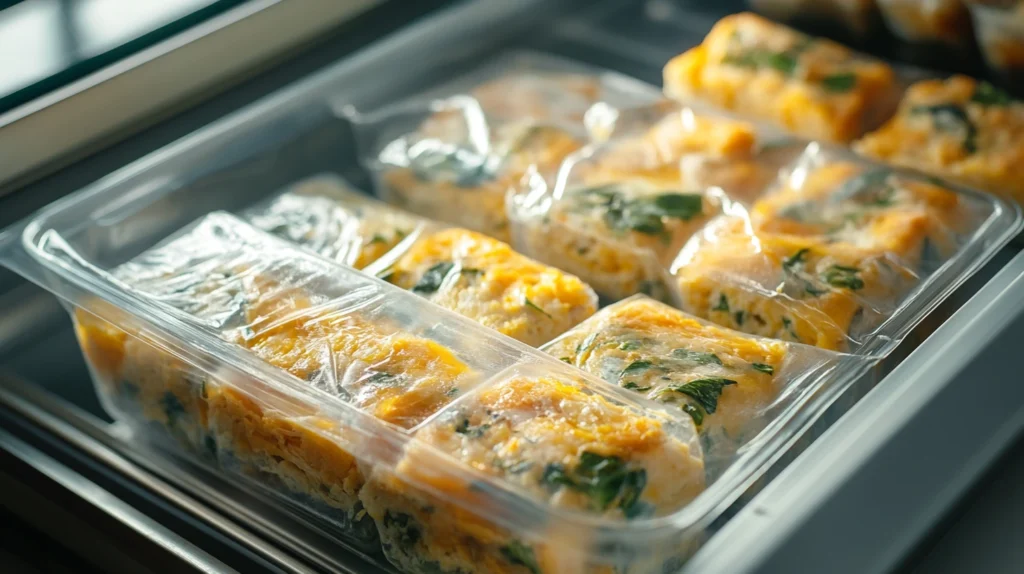
Fridge Storage Tips for Low Carb Egg Casseroles
- Keep leftovers in an airtight container in the fridge for up to four days.
- Allow the casserole to cool fully before refrigerating to avoid condensation (which leads to sogginess).
Best Practices to Freeze and Reheat Keto Casserole
- To Freeze: Slice into individual portions. Individually wrap each piece in foil or parchment paper, then store them in a freezer-safe bag. Label with the date.
- To Reheat: Microwave on medium for 60–90 seconds or warm in an oven at 300°F (150°C) for 10–15 minutes until heated through.
Frozen casseroles can last up to 2 months and retain their flavor and texture quite well when reheated properly.
Make-Ahead Keto Breakfast Casseroles for Meal Prep
Batch Cooking Your Weekly Keto Morning Meals
If you’re juggling work, family, or fitness goals, keto breakfast casserole is a meal-prep champion. Here’s how you can work it into your weekly meal routine:
- Make one casserole every Sunday and store slices in meal-prep containers.
- Pair with low-carb sides like avocado slices or a bulletproof coffee.
Portioning and Tracking Your Keto Casserole Macros
- Divide your casserole evenly into 6–8 portions.
- Use a food tracker like MyFitnessPal or Carb Manager to log ingredients and calculate precise macros per slice.
- Stick to portion sizes to stay within your daily carb and calorie goals.
Nutritional Breakdown of Keto Breakfast Casserole
Macronutrients in a Standard Low Carb Breakfast Casserole
A basic keto breakfast casserole (with eggs, sausage, spinach, cheese, and cream) generally provides:
- Calories: 350–450
- Fat: 28–35g
- Protein: 18–25g
- Net Carbs: 3–5g
These numbers can vary depending on your ingredient choices. Always scan or weigh your ingredients if you’re tracking macros precisely.
Customizing Keto Egg Casseroles to Fit Your Macros
- Need more fat? Add avocado, more cheese, or drizzle with olive oil.
- Need less protein? Use fewer meat fillings and increase fat-based ingredients.
- Need fewer carbs? Stick to green vegetables and avoid bell peppers or onions in large amounts.
Frequently Asked Questions
How many days can you eat breakfast casserole?
A keto breakfast casserole can be safely eaten for up to 4 days when stored properly in the refrigerator. Make sure to cool it completely before storing, and keep it in an airtight container to maintain freshness and prevent moisture buildup.To extend its shelf life, freeze the casserole in individual portions.
Why is my breakfast casserole soggy?
A soggy casserole is often the result of excess moisture from vegetables or underbaking. To fix or avoid this:
- Sauté high-moisture veggies like spinach, mushrooms, or zucchini before adding them.
- Avoid using too much cream or milk.
- Bake until the center is firm and no longer jiggly.
Let the casserole rest for 5–10 minutes after baking to allow it to firm up.
What does a good keto breakfast look like?
A proper keto breakfast is:
- Low in carbs (typically under 5g net carbs)
- High in healthy fats (from sources like eggs, avocado, butter, or cheese)
- Moderate in protein
A keto breakfast casserole fits perfectly—it’s loaded with eggs, cheese, meats, and low-carb veggies. Other good options include avocado with eggs, keto smoothies, or chia pudding with coconut milk.
How long can an egg casserole sit out?
Egg-based casseroles should not sit out longer than 2 hours at room temperature. After that, they enter the temperature danger zone (40°F to 140°F), where bacteria can grow rapidly. If it’s been left out too long, it’s safest to discard it.
Can you eat egg casserole cold?
Yes, you can eat keto egg casserole cold—especially if it’s already been cooked and stored properly. Many people enjoy it as a grab-and-go breakfast straight from the fridge. However, reheating enhances the texture and flavor, especially the melted cheese and tender eggs.
Are eggs safe at room temperature?
In the U.S., raw or cooked eggs should not be left at room temperature for more than 2 hours. Unlike some countries where eggs are not washed and can be stored unrefrigerated, U.S. eggs lose their natural protective coating during processing. Always refrigerate eggs and egg-based dishes like casseroles promptly to avoid foodborne illness.
Conclusion
A keto breakfast casserole is more than just a trend—it’s a game-changer for your mornings. Whether you’re prepping for the week ahead, feeding a crowd, or just want a warm and satisfying low-carb meal, this dish checks all the boxes. It’s easy to make, endlessly customizable, nutritious, and delicious.
With the right combination of ingredients, you’ll get the fat, protein, and flavor you need—while keeping carbs low and your energy high. From sausage and spinach to bacon and broccoli or dairy-free alternatives, the possibilities are endless.
So the next time you’re wondering, “What should I make for breakfast?”—remember this article, and go casserole. Your keto journey just got tastier.
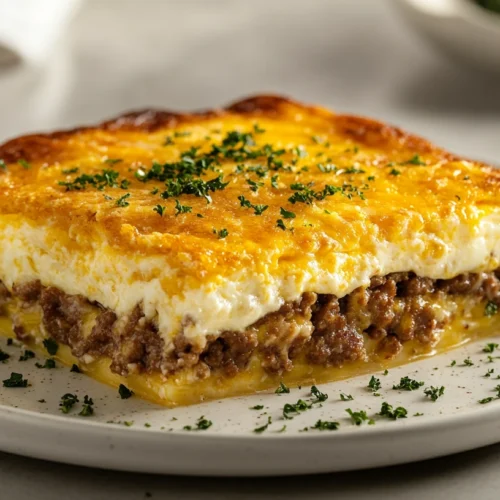
Keto Breakfast Casserole
Equipment
- 9×13-inch baking dish
- Large mixing bowl
- Frying pan or skillet
- Whisk
- Spatula
- Measuring cups and spoons
- Knife and cutting board
- Oven
Ingredients
- 10 large eggs
- 1 cup heavy cream
- 1 cup shredded cheddar cheese
- 1/2 cup mozzarella cheese optional
- 1/2 pound breakfast sausage sugar-free
- 1/2 cup diced bell peppers
- 1/2 cup chopped spinach or kale
- 1 tsp garlic powder
- 1/2 tsp paprika
- Salt and black pepper to taste
- Butter or coconut oil for greasing
Instructions
- Preheat oven to 375°F (190°C). Grease a 9×13-inch baking dish with butter or coconut oil.
- Cook the sausage in a skillet over medium heat until browned. Drain excess fat and set aside.
- Sauté vegetables (spinach, peppers) in the same skillet for 2–3 minutes until slightly soft.
- In a large mixing bowl, whisk together the eggs, heavy cream, garlic powder, paprika, salt, and pepper until smooth.
- Add cooked sausage, sautéed vegetables, and cheeses to the egg mixture. Stir to combine.
- Pour into the baking dish and spread evenly with a spatula.
- Bake for 35–45 minutes, or until the center is set and a toothpick comes out clean.
- Let the casserole cool for 5–10 minutes before slicing and serving.

